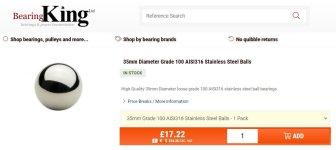Truth
Gold Member
I found it perfectly sphere 7” deep no rust marks at all and it is solid.
Attachments
-
 8FC08B08-D07A-4F7B-9B16-021400B83B9A.jpeg1,023.3 KB · Views: 575
8FC08B08-D07A-4F7B-9B16-021400B83B9A.jpeg1,023.3 KB · Views: 575 -
 2CED8105-E491-4F50-A55D-1451820B2223.jpeg1.8 MB · Views: 448
2CED8105-E491-4F50-A55D-1451820B2223.jpeg1.8 MB · Views: 448 -
 73AE2C78-4115-4CA0-B060-12479F4FE587.jpeg1 MB · Views: 435
73AE2C78-4115-4CA0-B060-12479F4FE587.jpeg1 MB · Views: 435 -
 3CF82813-E2EC-4040-B109-C9CE1328EF20.jpeg3.8 MB · Views: 406
3CF82813-E2EC-4040-B109-C9CE1328EF20.jpeg3.8 MB · Views: 406 -
 B2343367-ECFE-43B1-A132-1822DFFF874D.jpeg689 KB · Views: 385
B2343367-ECFE-43B1-A132-1822DFFF874D.jpeg689 KB · Views: 385 -
 3F6451DA-38B8-4D5A-BD3B-7B4D431185EC.jpeg3.6 MB · Views: 470
3F6451DA-38B8-4D5A-BD3B-7B4D431185EC.jpeg3.6 MB · Views: 470
Upvote
18













